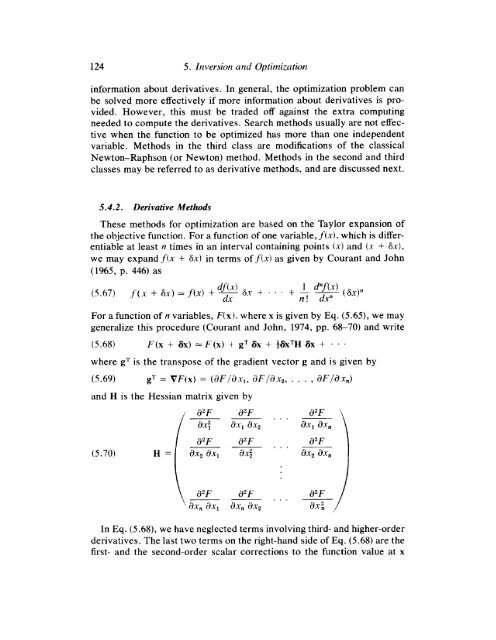principles and applications of microearthquake networks
principles and applications of microearthquake networks
principles and applications of microearthquake networks
Create successful ePaper yourself
Turn your PDF publications into a flip-book with our unique Google optimized e-Paper software.
124 5. Inversion <strong>and</strong> Optimization<br />
information about derivatives. In general, the optimization problem can<br />
be solved more effectively if more information about derivatives is provided.<br />
However, this must be traded <strong>of</strong>f against the extra computing<br />
needed to compute the derivatives. Search methods usually are not effective<br />
when the function to be optimized has more than one independent<br />
variable. Methods in the third class are modifications <strong>of</strong> the classical<br />
Newton-Raphson (or Newton) method. Methods in the second <strong>and</strong> third<br />
classes may be referred to as derivative methods, <strong>and</strong> are discussed next.<br />
5.4.2. Derivative Methods<br />
These methods for optimization are based on the Taylor expansion <strong>of</strong><br />
the objective function. For a function <strong>of</strong> one variable, f(x>, which is differentiable<br />
at least n times in an interval containing points (x) <strong>and</strong> (x + ax),<br />
we may exp<strong>and</strong> f (x + ax) in terms <strong>of</strong> f(x) as given by Courant <strong>and</strong> John<br />
( 1965, p. 446) as<br />
(5.67) f(x + ax) = f(x) + dm<br />
dX<br />
6s + . . . +-----<br />
1 d"f(x)<br />
n ! dx'l<br />
For a function <strong>of</strong> n variables, F(x), where x is given by Eq. (5.65), we may<br />
generalize this procedure (Courant <strong>and</strong> John, 1974, pp. 68-70) <strong>and</strong> write<br />
(5.68) F(x + 6x) = F(x) + g T 6x + @XTH 6x + . . .<br />
where gT is the transpose <strong>of</strong> the gradient vector g <strong>and</strong> is given by<br />
(5.69) gT = VF(x) = (dF/ds,, dF/dx2,<br />
<strong>and</strong> H is the Hessian matrix given by<br />
i<br />
a2F d2F<br />
ax; ax, ax2<br />
d2F a'F<br />
(5.70) H = ax2 as, ax;<br />
...<br />
..<br />
\<br />
I<br />
ax, ax,<br />
d2F<br />
ax, ax,<br />
a'F i)*F<br />
\ ax, ax, ax, ax, .<br />
In Eq. (5.68), we have neglected terms involving third- <strong>and</strong> higher-order<br />
derivatives. The last two terms on the right-h<strong>and</strong> side <strong>of</strong> Eq. (5.68) are the<br />
first- <strong>and</strong> the second-order scalar corrections to the function value at x






